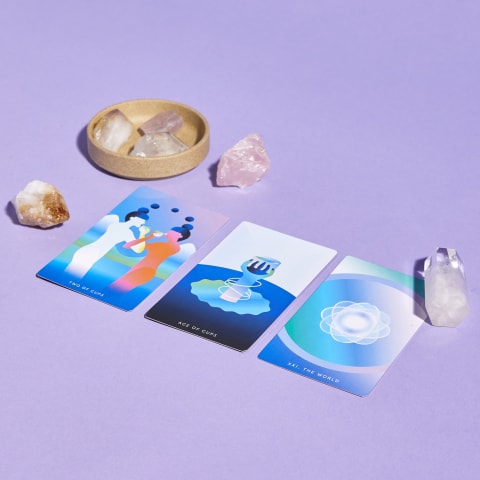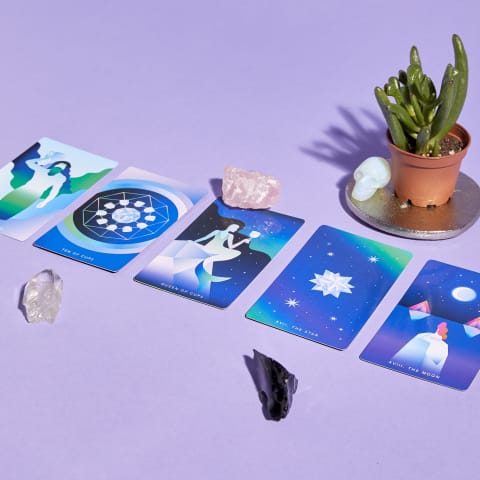Advertisement
How To Do A Basic Tarot Reading For Yourself Or A Friend


Ask 10 people about tarot cards, and nine of them will probably say they predict the future. That's almost right, but tarot doesn't tell you what will happen—it tells what might happen, and more importantly, how you should show up to it.
Here's what you need to know about finding the right tarot deck, pulling cards, and deciphering their useful messages.
What's in a tarot deck?
In the late 16th and early 17th centuries, tarot was a simple parlor game. Within another 100 years, though, it had become a popular tool for divination.
Today, both tarot and oracle cards, which have fewer rules and a wider range of content, are still in heavy rotation among modern mystics (or anyone looking for a sneak peek into the future).
The enlightened soul searcher has his or her pick of playing cards these days, with traditional decks like the Rider-Waite deck, first published in 1909, and any number of cool and creative decks that appeal to the individual.
The trick to finding the right deck? It's simple—opt for one that really speaks to you.
The standard tarot deck has 78 cards, and each one has its own imagery and symbolism. The cards are split into two categories: 22 Major Arcana cards and 56 Minor Arcana cards. Here's a quick lowdown on each, but you can find a more thorough explainer of the 78 tarot cards here.
Summary
Major Arcana
Major Arcana, also known as Trump cards, includes 21 numbered cards and a single unnumbered card known as the Fool. This character plays a pivotal role in the Major Arcana; he moves through each card, learning lessons along the way in what's known as the Fool's Journey.
A Major Arcana card is often complex and significant, and its appearance will influence the entire reading. It's often a prompt to reflect on your life's broader lessons and overall themes.
Minor Arcana
The 56 Minor Arcana cards relate to the more specific daily challenges of everyday life and our current situation.
They represent our thoughts, feelings, experiences, and beliefs. These cards are associated with a temporary kind of energy that's affecting your life at the moment and could be easily influenced one way or another.
The Minor Arcana cards are made up of four tarot suits that focus on different parts of our lives:
- Wands: These cards represent passion, energy, creativity, and sexuality, and are related to the fire element.
- Cups: This is the suit of love, and it represents emotions, feelings, and intuition. Cups are related to the water element.
- Swords: The Swords are intellectually driven, representing our thoughts, words, and action, and represent the air element.
- Pentacles: This suit recognizes the material world, offering guidance on our finances, career paths, and material possessions. Pentacles are related to the earth element.
Within each suit are the court cards—the King, Queen, Knight, and Page—and they can be interpreted in any number of ways. They may represent people, personalities, situations, or even the energy you need at the time of your reading.
How to do a reading
Understanding the general meaning of each card is just the beginning. The real power comes in using the cards to tap into your own intuition and wisdom so you can start taking positive steps into a brighter future.
Grab the deck you'd like to work with (making sure it's freshly cleansed). From there, tarot readings generally follow a simple format:
First, you need to ask the card deck a question.
It should be clear and open-ended. For example, avoid asking questions that begin with "Will I...," as they run the risk of locking you into a passive role in your own future.
The idea is to use the card reading to illuminate a path forward, so the tarot reader should ask questions that are broader. Here are a few frameworks to consider if you're new to tarot:
- "What do I need to know about...?"
- "How can I understand...?"
- "Why am I feeling anxious about...?"
- "Where is the hidden opportunity in...?"
- "What should I focus on in my relationship with...?"
- "How can I move past...?"
Once you have the question in your mind, it's time to shuffle.
There are multiple ways to shuffle tarot cards. The overhand shuffle involves holding the deck of cards in one hand and using the other to move cards from one side of the deck to the other.
You can also "cut" the deck by dividing it into several piles and then combining them into one again.
Or you can try spreading the cards facedown on the table and sweeping them into a big, messy pile before tapping them into place again.
There's no right or wrong way to do it: Give all these techniques a try, and see what feels right.
Pull your card(s).
Again, there are multiple ways to go here. Cutting the deck with your left hand and pulling the card on top is a simple, no-nonsense approach. You can also try holding the deck in your left hand and tilting it slightly so that part of the deck reveals a gap from which you can take the top card.
Or, you can fan the cards out like poker, and choose the card that draws your eye or feels right in your hand.
You're free to pull a single card for a simple reading or several cards for what's known as a spread. Instead of answering one question, tarot spreads can speak more broadly to your situation or life path. The more cards you use in a spread, the more in-depth the reading tends to be, but a big spread can be overwhelming for beginners.
Once you've chosen your card or cards, lay them facedown in your spread.
Then, turn them right side up so you can gaze at their words, symbols, and imagery, paying attention to what comes to mind as you go.
How to interpret the cards you pull
The key is to stay as calm and focused as you can to fully connect with your intuitive abilities by way of the cards. If you're drawing a complete blank about how a certain card relates to your question, check your deck's reference book for guidance on card meanings.
Simple tarot card spreads to start with
As I mentioned, there are an infinite number of ways to spread out your cards. If you're ready to branch out from single-card pulls and try more in-depth, multi-card spreads, here are a few to start with.
A three-card spread for centering yourself during chaotic experiences

This spread comes from intuitive tarot teacher and founder of Tarot For The Wild Soul Lindsay Mack. After shuffling, pull three cards from the stack. As you turn over each one, consider how they speak to the following. Remember to breathe slowly and evenly, and feel into your intuition as you go:
- Card 1: Represents what you can do to surrender to the change in your life.
- Card 2: Offers direction on caring for yourself during this process.
- Card 3: Serves as a guide for centering yourself in the midst of this change.
A five-card spread for illumination and clarity

For this spread, also inspired by Mack, shuffle your cards and choose the five that call to you, or cut the deck into five piles. Take a deep breath and pull a card for each question:
- Card 1: What is happening at the moment?
- Card 2: How can I weather it easily and with grace?
- Card 3: What is the lesson?
- Card 4: What is leaving at this time?
- Card 5: What is arriving at this time?
As your gaze at your cards and ponder these questions, take time to focus and reflect. It can be helpful to journal about your thoughts and feelings on each card for deeper interpretation.
How to use tarot as self-care
Meditation and mindfulness are essential skills in this day and age, and tarot is a path to building both.
Incorporating tarot into a daily, weekly, or monthly practice, or simply on an as-needed basis, will help you grow your intuitive abilities and tap into some of that inner wisdom we all have.
You can start reading tarot cards more consistently by drawing a card every morning when you wake up (or in the evenings before bed) that speaks to what you need to know about the day to come.
Think of it as an especially rewarding form of self-care that has the added benefit of helping you manifest a better, brighter future.
Summary
The takeaway
Doing a tarot reading can help you connect with your intuition and find answers that lie within about everything from love and relationships to life path. There's no right or wrong way to pull cards, but following a few best practices can help you get the most out of every reading.

These 6 Simple Steps Will Make The Age Of Aquarius Your Best Era Yet
Perpetua Neo, DClinPsy

These 6 Simple Steps Will Make The Age Of Aquarius Your Best Era Yet
Perpetua Neo, DClinPsy

These 6 Simple Steps Will Make The Age Of Aquarius Your Best Era Yet
Perpetua Neo, DClinPsy

These 6 Simple Steps Will Make The Age Of Aquarius Your Best Era Yet
Perpetua Neo, DClinPsy









